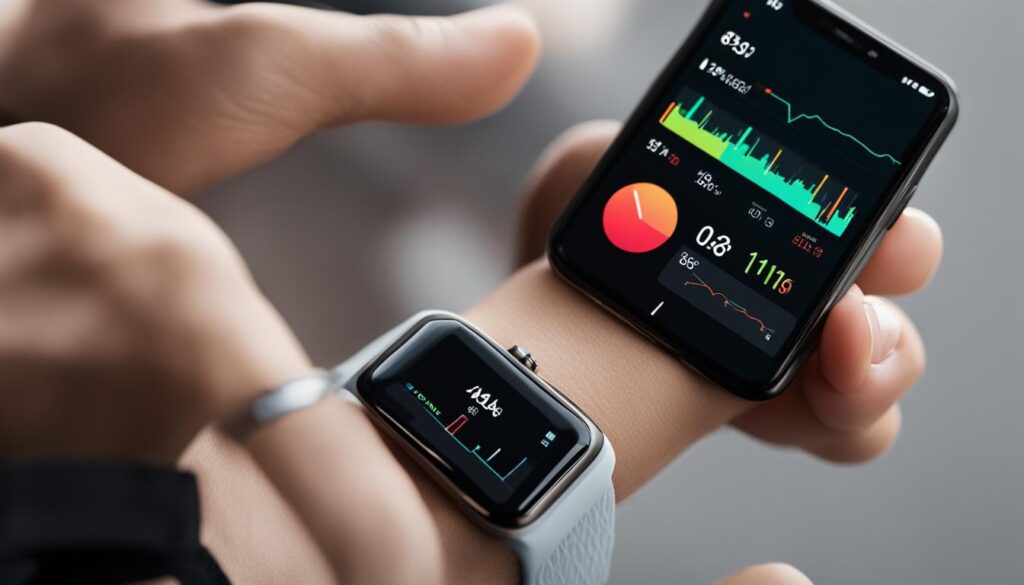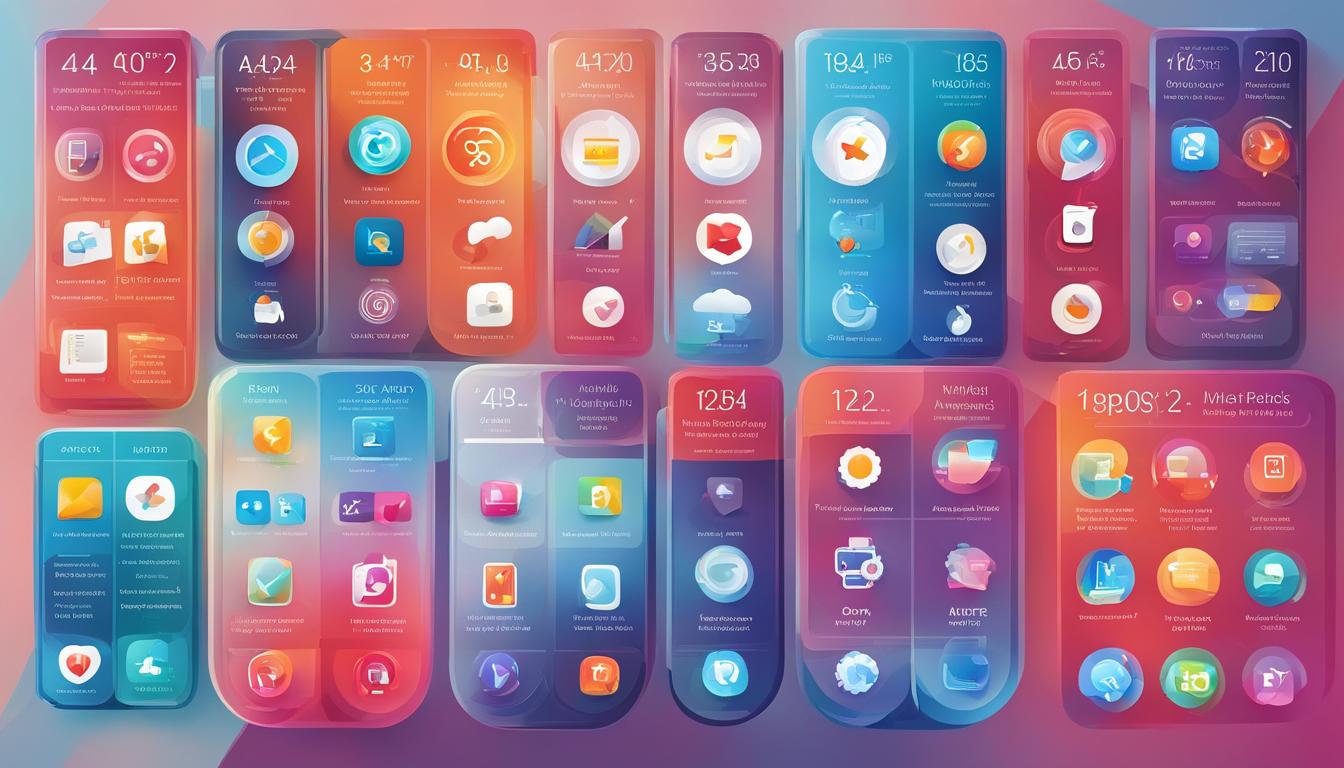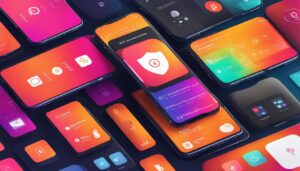In today’s healthcare landscape, mobile technology is rapidly advancing, and the use of mobile health apps is on the rise. As we approach 2024, the demand for these apps is expected to soar, revolutionizing the way patients access and manage their healthcare. In this comprehensive guide, I will delve into the world of mobile health apps, providing you with valuable insights and a comparative analysis to help you navigate the ever-expanding app market.
Key Takeaways:
- Mobile health apps are projected to drive significant growth in the patient-centric healthcare market by 2024.
- Patients expect user-friendly apps that provide easy access to essential functionalities and detailed, actionable information.
- Telemedicine/video consultation options, community features, and integration with wearable devices are key factors patients look for in a healthcare app.
- Intuitive interfaces, access to detailed information, and a simple yet amazing digital experience are crucial for app success.
- Integration with wearable devices and convenient appointment scheduling enhance patient engagement and healthcare outcomes.
What Do Patients Want in a Mobile Healthcare App?
When it comes to mobile healthcare apps, patients have certain expectations and preferences. In order to meet the needs of patients and provide a user-centric experience, it is important to understand what patients want in a mobile healthcare app.
Patient expectations revolve around convenience, personalized care, and easy access to information and services. They want healthcare apps that are useful, engaging, and aligned with their specific needs. Meeting these expectations can improve patient engagement and overall satisfaction with the app.
To fulfill patient expectations, healthcare apps should offer easy navigation, access to detailed information, telemedicine/video consultation options, community features, a simple and amazing digital experience, integration with wearable devices, appointment scheduling, and secure messaging. These features allow patients to have a seamless and personalized experience while managing their healthcare needs.
By focusing on patient expectations and adopting a patient-centric approach, healthcare organizations can develop mobile healthcare apps that truly make a difference in the lives of patients. It is important to keep patients at the center of app development and continuously improve the app based on their feedback and changing needs.
| What Patients Want in a Mobile Healthcare App | Key Features |
|---|---|
| Easy navigation | Intuitive and simple interfaces |
| Access to information | Easy access to health information and medical records |
| Telemedicine/Video consultation | Convenient interaction with healthcare professionals |
| Community features | Connect and interact with other patients |
| Simple digital experience | User-friendly UI and attractive data visualization |
| Integration with wearable devices | Real-time health data and better health monitoring |
| Appointment scheduling | Convenient booking and avoiding long wait times |
Easy-to-Use and Navigate App Interface
Patient satisfaction with healthcare apps is greatly influenced by the app’s ease of use and navigation. When patients download a healthcare app, they expect to be able to navigate through its features effortlessly to access the information and functionalities they need. An intuitive and simple interface plays a crucial role in enhancing the overall user experience.
One key aspect of an easy-to-use app interface is easy navigation. Patients should be able to find basic features and functionalities quickly without any confusion. Clear and visible menu options and buttons can help users understand the app’s structure and how to access different sections or services. By streamlining the navigation process, healthcare apps can save patients valuable time and effort.
Moreover, an effective app interface should prioritize user-friendly design principles. This includes the use of intuitive icons, meaningful labels, and logical organization of content. The visual elements should be visually appealing and consistent, allowing patients to engage with the app seamlessly. To ensure inclusivity, larger icons and text sizes may be necessary to accommodate older users or those with visual impairments.
Overall, an easy-to-use and navigate app interface is essential for patient satisfaction and engagement. By prioritizing simplicity, intuitive design, and efficient navigation, healthcare apps can provide users with a seamless digital experience that meets their needs and expectations.
Access to Detailed, Actionable Information
When it comes to healthcare apps, patients are looking for quick and easy access to detailed, actionable information. They want to be able to find their health information, medical records, test results, and other relevant data with just a few taps on their mobile devices. Providing patients with this level of access empowers them to take control of their health and make informed decisions.
One of the key benefits of healthcare apps is the ability to provide patients with personalized insights and recommendations based on their health data. These apps can help patients monitor specific health conditions, track their progress over time, and receive prompts for preventative actions. By presenting this information in a clear and understandable format, healthcare apps encourage patients to take proactive steps towards better health.
An engaging way to enhance the user experience is to provide interactive tools within the app. For example, patients can input their symptoms and receive potential diagnoses or recommendations for further action. This interactive feature helps users better understand their health concerns and encourages them to seek appropriate care.

Patient Testimonial:
“Having easy access to my health information through a mobile app has been a game-changer for me. I can view my test results, track my progress, and even receive personalized recommendations. It empowers me to be proactive about my health and make informed decisions.”
The Importance of Data Security:
While access to information is important, it is crucial for healthcare apps to prioritize data security. Patients need to feel confident that their personal health information is protected and cannot be accessed by unauthorized individuals. Implementing robust security measures, such as encryption and secure messaging, is essential to building trust with app users.
In conclusion, access to detailed, actionable information is a vital component of any healthcare app. By providing patients with easy access to their health data, personalized insights, and interactive tools, these apps empower individuals to take charge of their well-being and make informed healthcare decisions.
Telemedicine / Video Consultation with Healthcare Professionals
In today’s digital age, the integration of telemedicine and video consultation in healthcare apps has revolutionized the way patients interact with healthcare professionals. Telemedicine allows patients to connect with their providers remotely, eliminating the need for in-person visits and providing convenient access to healthcare services. This feature has gained immense popularity due to its ability to save time, increase accessibility, and enhance patient care.
Video consultations offer a unique opportunity for patients to have face-to-face interactions with healthcare professionals from the comfort of their homes. By leveraging video technology, patients can discuss their symptoms, ask questions, and receive medical advice without the need for physical appointments. This not only saves patients the hassle of travel and waiting times but also ensures timely access to healthcare expertise.
Furthermore, telemedicine and video consultation have proven to be particularly beneficial for patients in remote areas or with mobility issues. These individuals often face challenges in accessing specialized healthcare services. With the integration of telemedicine in healthcare apps, patients can easily connect with specialists, no matter their geographic location. This removes barriers to care and ensures that patients receive the medical attention they need.
Telemedicine and video consultation have transformed the patient experience by providing convenient access to healthcare professionals. Patients can now receive expert medical advice, discuss their concerns, and receive necessary care without leaving their homes. This technology has not only improved accessibility but has also enhanced the overall quality of healthcare.
Benefits of Telemedicine / Video Consultation:
- Convenient access to healthcare services from anywhere, anytime
- Reduced travel and waiting times
- Improved accessibility for patients in remote areas or with mobility issues
- Opportunity for face-to-face interactions with healthcare professionals
- Enhanced patient care and medical advice
- Increased efficiency in healthcare delivery
Community Features for Patient Interaction
Patient interaction is an essential aspect of healthcare apps, and incorporating community features can greatly enhance the user experience. By providing a platform for patients to connect and interact with each other, healthcare apps foster a supportive community that promotes engagement and healthy behaviors. Whether it’s sharing experiences, seeking advice, or offering support, patients benefit from the sense of belonging and connection that a community feature provides.
One of the key advantages of community features is the ability for patients to connect with others who have similar conditions. This creates a space where individuals dealing with similar health challenges can exchange information, share coping strategies, and offer emotional support. The supportive community within a healthcare app can help patients feel understood and validated, reducing feelings of isolation and improving overall well-being.
Moreover, community features encourage active participation and engagement with the app. By allowing patients to contribute to discussions, post updates, and interact with each other, healthcare apps can deepen the sense of involvement and ownership among users. This not only increases overall app usage but also fosters a stronger sense of loyalty and satisfaction among patients. As a result, healthcare organizations can benefit from improved patient retention and increased positive user reviews.

Benefits of Community Features in Healthcare Apps
- Access to support and advice from individuals with similar health conditions
- Reduction in feelings of isolation and improved emotional well-being
- Opportunity for patients to share experiences and coping strategies
- Increased engagement and active participation within the app
- Enhanced patient retention and loyalty
By incorporating community features into healthcare apps, we can create a space where patients feel supported, empowered, and connected. This supportive community not only improves the overall user experience but also contributes to better health outcomes by fostering engagement and healthy behaviors.
Simple Yet Amazing Digital Experience
In today’s digital age, user experience plays a crucial role in the success of any mobile app, including healthcare apps. Patients expect a simple yet amazing digital experience when using healthcare apps to manage their health and wellness. A user-friendly UI, attractive data visualization, and intuitive navigation are key factors that contribute to a positive user experience.
When designing a healthcare app, it is important to create a visually appealing interface that engages users from the moment they open the app. Colors, fonts, and overall design should be pleasing to the target audience, with special consideration for the needs of older users who may require larger icons and text. By prioritizing usability and aesthetics, healthcare apps can create an immersive digital experience that keeps patients engaged and encourages them to continue using the app.
To further enhance the digital experience, data visualization can be employed to present complex health information in a simple and understandable format. Visuals such as charts, graphs, and infographics can help patients make sense of their health data and track their progress over time. Providing clear and meaningful data visualization allows patients to take control of their health and make informed decisions about their well-being.
| Benefits of a Simple and Amazing Digital Experience in Healthcare Apps: |
|---|
| Enhances user engagement and retention |
| Improves patient satisfaction and overall experience |
| Increases usability and ease of navigation |
| Empowers patients to take control of their health |
By prioritizing a simple yet amazing digital experience in healthcare apps, organizations can provide patients with a platform that is not only functional but also visually appealing and user-friendly. This approach creates a positive impression, fosters patient engagement, and ultimately contributes to improved healthcare outcomes.
Integration with Wearable Devices
The integration of healthcare apps with wearable devices is revolutionizing the way patients monitor and manage their health. By seamlessly connecting with devices such as fitness trackers, smartwatches, and heart rate monitors, these apps provide real-time health data that enables better health monitoring.
Patients can track their heart rate, blood pressure, sleep patterns, and other vital signs, allowing them to stay informed about their health at all times. This real-time data empowers individuals to make informed decisions about their lifestyle and take proactive steps towards managing their health conditions effectively.
Moreover, the integration with wearable devices enhances the convenience and personalization of healthcare apps. Patients no longer need to manually enter their health data; instead, it is automatically synced from their devices to the app. This saves time and effort for both patients and healthcare providers, enabling a more streamlined and efficient healthcare experience.

The Benefits of Integration with Wearable Devices
- Real-time health monitoring
- Convenient and automatic data syncing
- Improved patient engagement
- Enhanced personalization of healthcare
- Better management of health conditions
By integrating with wearable devices, healthcare apps are able to provide patients with a comprehensive and holistic view of their health. This integration not only improves patient outcomes but also empowers individuals to take an active role in managing their well-being.
Appointment Scheduling
In today’s fast-paced world, convenience is key, and that applies to healthcare as well. Patients want a seamless and hassle-free experience when it comes to booking appointments. With the advancements in mobile health apps, appointment scheduling has become easier and more convenient than ever before.
By incorporating an appointment scheduling feature, healthcare apps empower patients to take control of their healthcare journey. Whether it’s scheduling a routine check-up, booking a specialist consultation, or reserving a slot for a diagnostic test, patients can do it all with just a few taps on their smartphones.
Convenient booking directly through the app eliminates the need for making phone calls, waiting on hold, or visiting the hospital in person to schedule an appointment. This not only saves valuable time for patients but also helps them avoid long wait times, ensuring a smoother and more efficient healthcare experience.
Conclusion
In conclusion, the development of healthcare apps must prioritize a patient-centric approach. By focusing on the needs and preferences of users, healthcare organizations can create apps that truly enhance the patient experience.
It is crucial for healthcare apps to be easy to navigate, allowing patients to access detailed and actionable information at their fingertips. The integration of telemedicine and video consultation options provides convenient access to healthcare professionals, saving patients time and effort. Additionally, incorporating community features fosters an interactive and supportive environment within the app.
A simple yet amazing digital experience is essential for patient engagement and retention. By providing a user-friendly interface and attractive data visualization, healthcare apps can create a smooth and elegant user experience. Integration with wearable devices enables real-time health monitoring and personalized care, leading to better healthcare outcomes.
Moreover, appointment scheduling features streamline the process, allowing patients to conveniently book appointments and avoid long wait times. By adopting a patient-centric approach, healthcare organizations can improve patient engagement, satisfaction, and overall healthcare outcomes. In the rapidly evolving landscape of healthcare technology, it is imperative to develop innovative and patient-focused healthcare apps.
FAQ
What are the key factors patients look for in a healthcare app?
Patients look for easy navigation, access to detailed information, telemedicine/video consultation options, community features, a simple and amazing digital experience, integration with wearable devices, appointment scheduling, and secure messaging in a healthcare app.
What do patients expect in terms of app interface?
Patients expect intuitive and simple interfaces in healthcare apps that are easy to navigate and understand. Basic features should be easily accessible, without making them hard to find.
What information should a healthcare app provide to patients?
Healthcare apps should provide easy access to health information, medical records, test results, and other relevant information. Patients want to be able to keep track of their health status over time, monitor specific health conditions, and take proactive steps to manage their health.
How can patients interact with healthcare professionals through a healthcare app?
Patients can interact with healthcare professionals through telemedicine or video consultations. This allows them to consult with their providers without having to visit in-person, saving time and effort.
Can patients connect with each other within healthcare apps?
Yes, patients can connect and interact with each other within healthcare apps. Adding a community feature allows patients to connect with others who have similar conditions, providing a supportive environment and enhancing healthy behaviors.
What should the user experience be like in a healthcare app?
The user experience in a healthcare app should be smooth and elegant. The app should have a user-friendly UI with attractive data visualization. Colors and overall design should be pleasing to the target audience, while bigger icons and text may be necessary for older users.
How can wearable devices be integrated with healthcare apps?
Healthcare apps can be integrated with wearable devices, allowing patients to monitor their real-time health data such as heart rate, blood pressure, and sleep patterns. This integration improves health monitoring, convenience, personalization, patient engagement, and overall healthcare outcomes.
Can patients book appointments through a healthcare app?
Yes, healthcare apps should allow patients to easily book appointments without having to make phone calls or visit in-person. This feature enhances the patient experience and increases efficiency in healthcare scheduling.





